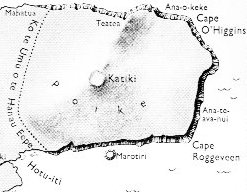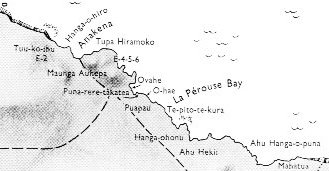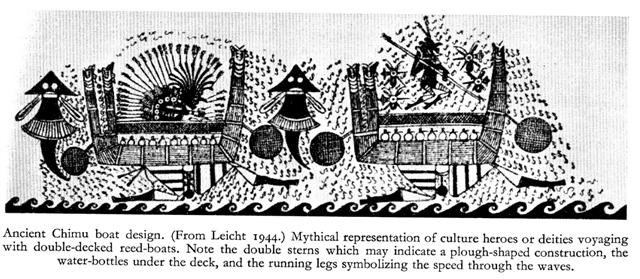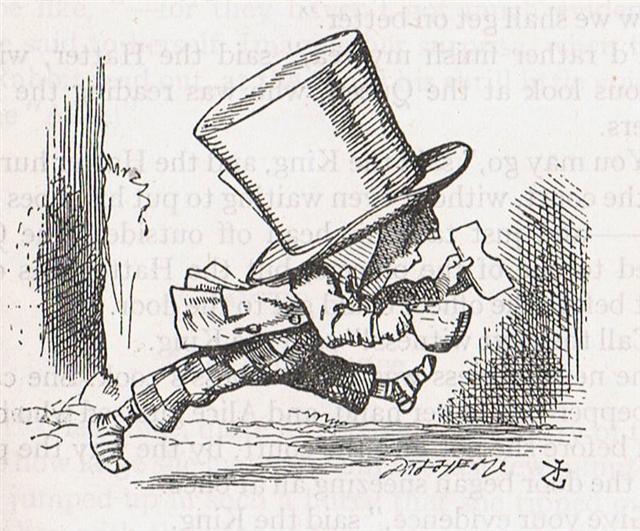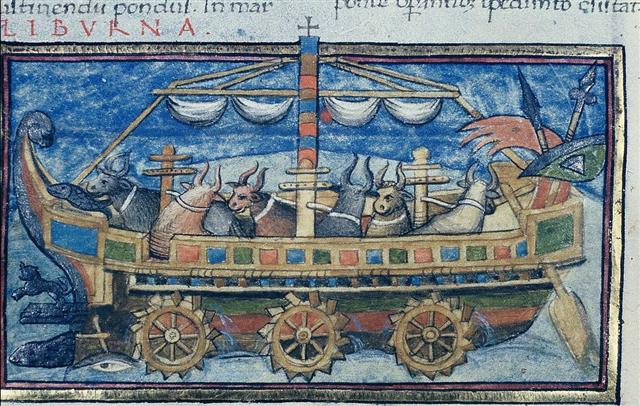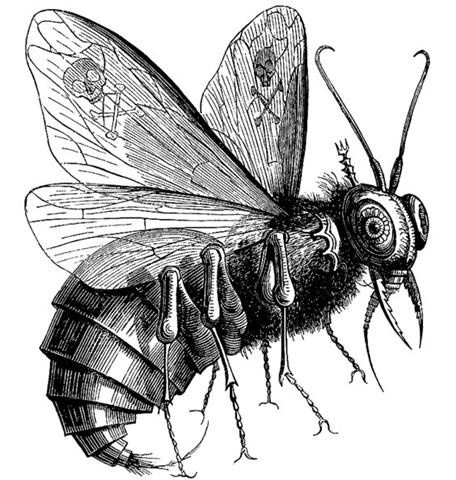86. Manuscript E included not only facts but also plenty of allusions. For those of us still in the dark these can be treated as riddles to be solved. First there was the different length for the sea voyage of Hotu A Matua (288 - 245 = 43 days) compared to that of the Explorers (152 - 115 = 37 days). I have tried to explain - by comparing - these 37 days with the distance from Cursa (*72) to Castor (*109), although not at the time of the Pope but at the time of Bharani, with Castor (*72) - Cursa (*35) = 37 = 41 (precessional depth down to Bharani ) - 4 (precessional depth down to the Pope):
The Pope Gregory XIII could be involved because he had launched an updated and strange version of the Julian calendar, which to be understood might have motivated the fishhooks at Sirius as signs which everyone would be able to comprehend:
Once upon a time Land (the 'Fish') had been reached ('drawn up') at the place where Castor - followed by his half-brother Pollux 3 days later - went up from the Milky Way river. ... The earth rises up from the sea again, and is green and beautiful and things grow without sowing. Vidar and Vali are alive, for neither the sea nor the flames of Surt have hurt them and they dwell on the Eddyfield, where once stood Asgard. There come also the sons of Thor, Modi and Magni, and bring along his hammer. There come also Balder and Hoder from the other world. All sit down and converse together. They rehearse their runes and talk of events of old days. Then they find in the grass the golden tablets that the Aesir once played with. Two children of men will also be found safe from the great flames of Surt. Their names, Lif and Lifthrasir, and they feed on the morning dew and from this human pair will come a great population which will fill the earth. And strange to say, the sun, before being devoured by Fenrir, will have borne a daughter, no less beautiful and going the same ways as her mother ...
For the King his 43 days at sea could be explained as (compared to) the difference between 80 and 37 days, a measure corresponding to moving 80 days ahead to the SEPTEMBER equinox and then changing the time frame from that of Bharani to that of the Pope:
The Explorers went sailing through much milky waters (Vaitu Nui - Vaitu Potu) and reached the dry (maro) time of Easter Island in the first day of the dark midwinter month of "June (Maro). At the time of rongorongo the Sun was rising with Canopus in June 24 (175, St John's Day).
Castor (*113) - Canopus (*95) = Castor (*72 = *113 - 41) - Canopus (*54 = *95 - 41) = 18 (Saturn). ... The Pythagoreans make Phaeton fall into Eridanus, burning part of its water, and glowing still at the time when the Argonauts passed by. Ovid stated that since the fall the Nile hides its sources. Rigveda 9.73.3 says that the Great Varuna has hidden the ocean. The Mahabharata tells in its own style why the 'heavenly Ganga' had to be brought down. At the end of the Golden Age (Krita Yuga) a class of Asura who had fought against the 'gods' hid themselves in the ocean where the gods could not reach them, and planned to overthrow the government. So the gods implored Agastya (Canopus, alpha Carinae = Eridu) for help. The great Rishi did as he was bidden, drank up the water of the ocean, and thus laid bare the enemies, who were then slain by the gods. But now, there was no ocean anymore! Implored by the gods to fill the sea again, the Holy One replied: 'That water in sooth hath been digested by me. Some other expedient, therefore, must be thought of by you, if ye desire to make endeavour to fill the ocean ...
Canopus interrupted the water cycle driven by the Sun. Instead of sucking up water and then releasing it as rain he interrupted the circulation. ... The life-force of the earth is water. God moulded the earth with water. Blood too he made out of water. Even in a stone there is this force, for there is moisture in everything. But if Nummo is water, it also produces copper. When the sky is overcast, the sun's rays may be seen materializing on the misty horizon. These rays, excreted by the spirits, are of copper and are light. They are water too, because they uphold the earth's moisture as it rises. The Pair excrete light, because they are also light ... 'The sun's rays,' he went on, 'are fire and the Nummo's excrement. It is the rays which give the sun its strength. It is the Nummo who gives life to this star, for the sun is in some sort a star.' It was difficult to get him to explain what he meant by this obscure statement. The Nazarene made more than one fruitless effort to understand this part of the cosmogony; he could not discover any chink or crack through which to apprehend its meaning. He was moreover confronted with identifications which no European, that is, no average rational European, could admit. He felt himself humiliated, though not disagreeably so, at finding that his informant regarded fire and water as complementary, and not as opposites. The rays of light and heat draw the water up, and also cause it to descend again in the form of rain. That is all to the good. The movement created by this coming and going is a good thing. By means of the rays the Nummo draws out, and gives back the life-force. This movement indeed makes life ...
At the time of rongorongo Sirius - the star which caused the waters to rise again - came 6 days after Canopus. At the time of Hyadum II the distance would (as inferred by extrapolation) have been 6 + 64 = 70 (= 350 / 5) right ascension days. JUNE 30 (181) + 64 = 245 (*165) at Alkes (α Crateris). Therefore the date given as Hora Nui 2 in Manuscript E should refer to September 2 and not to the corresponding date in the Gregorian calendar at the time of the Pope (which I up to now have suggested). It was always the current Sun who ruled the dates in the Sun calendar.
In which case we could count back to the time frame of Bharani as follows: September 2 (245) - 41 = 204 ("July 23) = 288 ("October 15) - 84 (12 weeks, Julian equinox). Manuscript E has other clues which might be relevant for our discussion: "Matua [A Taana] said to Hotu [A Matua], 'Take along the Hanau Eepe [the thick-set race] and let them work the land!' Hotu called out to Heke: 'Go and bring the 500 prisoners on board the canoe!' He took all of them along, led them on board the canoe, and left them there. For six days (po ono), mats (moenga) were taken on board the canoe (i.e., the loading of the canoe took six days)." (E:73-74)
We could for instance try to add 6 (ono) + 84 = 90, which suggests we should use the Julian date for equinox rather than the Gregorian (where 6 + 80 = 86 makes far less sense). There should be a quarter of a year before spring equinox and (366 - 6) / 4 = 90. From Sirius at Alkes (with the Mouth of the Fish at the Full Moon) and to Antares at spring equinox there were 84 days - and there were 6 days to Sirius from JUNE 24 (the day of St John):
These 500 'prisoners' were to be settled high up in the northeast on the Poike peninsula which seems to harmonize with the time when the Explorers were leaving Hanga Takaure. Probably 500 alluded to day 365 + 135 and to Tau-ono, the final of the previous Pleiades year. ... They put the injured Kuukuu on a stretcher and carried him inland. They prepared a soft bed for him in the cave and let him rest there. They stayed there, rested, and lamented the severely injured Kuukuu. Kuukuu said, 'Promise me, my friends, that you will not abandon me!' They all replied, 'We could never abandon you!' They stayed there twenty-seven days in Oromanga. Everytime Kuukuu asked, 'Where are you, friends?' they immediately replied in one voice, 'Here we are!' They all sat down and thought. They had an idea and Ira spoke, 'Hey, you! Bring the round stones (from the shore) and pile them into six heaps of stones!' One of the youths said to Ira, 'Why do we want heaps of stone?' Ira replied, 'So that we can all ask the stones to do something.' They took (the material) for the stone heaps (pipi horeko) and piled up six heaps of stone at the outer edge of the cave. Then they all said to the stone heaps, 'Whenever he calls, whenever he calls for us, let your voices rush (to him) instead of the six (of us) (i.e., the six stone heaps are supposed to be substitutes for the youths). They all drew back to profit (from the deception) (? ki honui) and listened. A short while later, Kuukuu called. As soon as he had asked, 'Where are you?' the voices of the stone heaps replied, 'Here we are!' All (the youths) said, 'Hey, you! That was well done!' ... In Ga4-13, where we should read 413 = 14 * 29½, there is a henua indicating emptiness before 6 feathers in front:
The Bay of Flies (Hanga Takaure) could have had much vigorous life spirits whereas Hanga Hoonu could have been the contrary - a lazy place where time went slowly as treacle, a place lacking in vital movements (vai ora), still dormant. ... From a religious point of view, the high regard for flies, whose increase or reduction causes a similar increase or reduction in the size of the human population, is interesting, even more so because swarms of flies are often a real nuisance on Easter Island, something most visitors have commented on in vivid language. The explanation seems to be that there is a parallel relationship between flies and human souls, in this case, the souls of the unborn. There is a widespread belief throughout Polynesia that insects are the embodiment of numinous beings, such as gods or the spirits of the dead, and this concept extends into Southeast Asia, where insects are seen as the embodiment of the soul ... ... When the new moon appeared women assembled and bewailed those who had died since the last one, uttering the following lament: 'Alas! O moon! Thou has returned to life, but our departed beloved ones have not. Thou has bathed in the waiora a Tane, and had thy life renewed, but there is no fount to restore life to our departed ones. Alas ...
But onboard the double ships of the Sun there was much fresh water:
The quickest sea-going vessel was the double-canoe and in the days at the end of the previous year (JUNE 30 / DECEMBER 30) a canoe of sand could have signified the need to hurry up with the return of life buried under the sands of One Tea.
... Miro-oone, model boat made of earth in which the 'boat festivals' used to be celebrated ... on the first day of the year the natives dress in navy uniforms and performs exercises which imitate the maneuvers of ships' crews ...
The Explorers arrived to a bay with very little water, to Hanga Te Pau. ... To run out (food, water): ekó pau te kai, te vai, is said when there is an abundance of food or water, and there is no fear of running out. Puna pau, a small natural well near the quarry where the 'hats' (pukao) were made; it was so called because only a little water could be drawn from it every day and it ran dry very soon ...
The Sun King, on the other hand, rushed to a place which would receive plenty of new life, to a bay of birth, to Hanga Rau (the Bay of Leaves). ... the Icelanders reckoned in misseri, half-years, not in whole years, and the rune-staves divide the year into a summer and a winter half, beginning on April 14 and October 14 respectively. But in Germany too, when it was desired to denote the whole year, the combined phrase 'winter and summer' was employed, or else equivalent concrete expressions such as 'in bareness and in leaf', 'in straw and in grass' ... Hotu brought the water cycle to Easter Island and in form of Antares (Rehua) he ripened all fruit (hua).
... In traditional navigational schools on Puluwat in the Caroline Islands, students learn how to sail outrigger canoes. As Puluwat sailors conceptualize a voyage between two islands, it is the islands that move rather than the canoe: the starting point recedes as the destination approaches ... ... 4 March 1779. The British ships are again at Kaua'i, their last days in the islands, some thirteen months since their initial visit. A number of Hawaiian men come on board and under the direction of their women, who remain alongside in the canoes, the men deposit navel cords of newborn children in cracks of the ships' decks (Beaglehole 1967:1225). For an analogous behavior observed by the missionary Fison on the Polynesian island of Rotuma, see Frazer (1911, 1:184). Hawaiians are connected to ancestors (auumakua), as well as to living kinsmen and descendants, by several cords emanating from various parts of the body but alike called piko, 'umbilical cord'. In this connection, Mrs. Pukui discusses the incident at Kaua'i: I have seen many old people with small containers for the umbilical cords... One grandmother took the cords of her four grandchildren and dropped them into Alenuihaha channel. 'I want my granddaughters to travel across the sea!' she told me. Mrs. Pukui believes that the story of women hiding their babies' pikos in Captain Cook's ship is probably true. Cook was first thought to be the god Lono, and his ship his 'floating island'. What woman wouldn't want her baby's piko there?
... 'Who are you talking to?' said the King, coming up to Alice, and looking at the Cat's head with great curiosity. 'It's a friend of mine - a Cheshire-Cat,' said Alice: 'allow me to introduce it.' 'I don't like the look of it at all,' said the King: 'however, it may kiss my hand, if it likes.' 'I'd rather not,' the Cat remarked. 'Don't be impertinent,' said the King, 'and don't look at me like that!' He got behind Alice as he spoke. 'A cat may look at a king,' said Alice. 'I've read that in some book, but I don't remember where.' 'Well, it must be removed,' said the King very decidedly: and he called to the Queen, who was passing at the moment, 'My dear! I wish you would have this cat removed!' The Queen had only one way of settling all difficulties, great or small. 'Off with his head!' she said without even looking around ...
|
|||||||||||||||||||||||||||||||||||||||||||||||||||||||||||||||||||||||||||||||||||||||||||||||||||||||||||||||||||||||||||||||||||||||||||||||||||||||||||||||||||||||||||||||||||||||||||||||||||||||||||||||||||||||||||||||||||||||||||||||||||||||||||||||||||||||||||||||||||||||||||||||||||||||||||||||||||||||||||||||||||

















